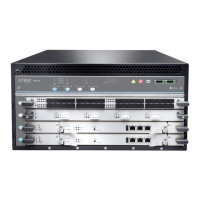NOTE: Nonstop active routing (NSR) and graceful Routing Engine switchover
(GRES) are not supported during the upgrade and they must be temporarily
disabled. Disable NSR by removing the nonstop-routing statement from the
[edit routing-options] hierarchy level and by removing the graceful-switchover
statement from the [edit chassis redundancy] hierarchy level .
1.
Removing the Routing Engine on page 288
2.
Installing the Routing Engine RE-S-X6-64G on page 290
3.
Verifying and Configuring the Upgraded Routing Engine as the Master on page 293
4.
Verifying and Configuring the Upgraded Routing Engine as the Backup on page 293
Removing the Routing Engine
To remove the backup Routing Engine from the chassis (see Figure 125 on page 289,
Figure 126 on page 289, and Figure 127 on page 290):
1. On the external management device connected to the Routing Engine, shut down the
host subsystem by using the request system power-off command.
2. Wait until a message appears on the console confirming that the operating system
has halted.
3. Remove the cables connected to the Routing Engine.
4. Place an electrostatic bag or antistatic mat on a flat, stable surface. Attach an
electrostatic discharge (ESD) grounding strap to your bare wrist and connectthe strap
to one of the ESD points on the chassis.
5. Verify that the Routing Engine LEDs are off. Loosen the captive screws on the top and
bottom of the Routing Engine.
6. Grasp the Routing Engine by the ejector handles, and slide it about halfway out of the
chassis.
7. Place one hand underneath the Routing Engine to support it, and slide it completely
out of the chassis. Place the Routing Engine on the antistatic mat.
NOTE: To maintain proper airflow through the chassis, do not leave an SCB
installed inthe chassis without a Routing Engine for extended periods of time.
If a Routing Engine is removed, a replacement Routing Engine should be
installed as soon as possible.
Copyright © 2017, Juniper Networks, Inc.288
MX240 3D Universal Edge Router Hardware Guide

